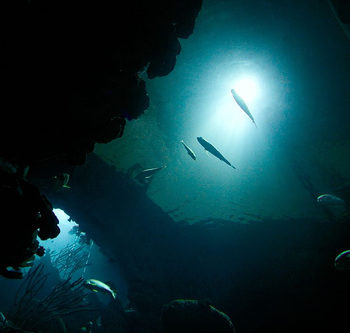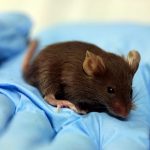Harnessing electricity and transporting it over long distances is arguably one of the most important innovations that humans have produced.(a)
The ability to transmit electric energy and impulses through wires has enabled basically every form of technology and communication at our disposal. As it turns out, however, humans were not the first creatures to find a means to conduct electric current. A recent report in the journal Nature describes a newly discovered species of bacteria that long ago beat us to the punch when it comes to long distance electron transport.1
Previously, scientists had observed electric currents in marine sediment, but had no clear idea how electrons were conducted from deeper, oxygen-free regions of the sediment up towards the surface. A group of Danish scientists led by Lars Peter Nielson took sediment from Aarhus Bay and transplanted it to aquariums in a lab. In this transplanted sediment, they were able to identify the same electrical currents that had been observed in the wild. When they began sifting through this sediment, they found long filaments made up of thousands of what DNA sequencing would later reveal to be a new member of the Desulfobulbaceae bacterial family.(b) When they cut the filaments using a tungsten wire, electrical conduction was blocked, demonstrating that these strings were facilitating the electron transport.
Using electron microscopy, the researchers looked more closely at the bacterial filaments and discovered an elegant and unusual structure: the normally smooth exteriors were covered with a series of ridges that were continuous from one bacterium to the next, running along the entire length of a filament. The researchers found evidence that these structures contain a shared, conductive periplasm that facilitates the transport of electrons from one end of the filament to the other.(c) In doing so, these ridges allow the bacteria to create an electric current between the oxygen-rich regions at the surface of the seafloor and the oxygen-deprived regions further down in the sediment layer. The currents enable the bacteria to perform what is known as a redox reaction.2 By forming cooperative, electron conductive filaments, this newly discovered species has devised a way to thrive in an environment where it has no business surviving.
As these bacteria have just been identified, there is little known about their evolutionary history. However, it is a safe bet that when humans first began engineering and placing long metal cables on the sea floor in order to transmit telegrams from one continent to another, we were placing those cables on top of bacteria that had developed their own electron conducting wires many thousands, if not millions, of years before.
Endnotes
- Christian Pfeffer, Steffen Larsen, Jie Song, Mingdong Dong, Flemming Besenbacher, Rikke Louise Meyer, Kasper Urup Kjeldsen, Lars Schreiber, Yuri A. Gorby, Mohamed Y. El-Naggar, Kar Man Leung, Andreas Schramm, Nils Risgaard-Petersen, and Lars Peter Nielsen (2012) “Filamentous bacteria transport electrons over centimetre distances,” Nature, 491: 218–221.
- Redox reactions involve the transfer of electrons from an ‘oxidized’ element, in this case sulphur, to a ‘reduced’ element, in this case oxygen. These reactions must always be balanced, and generally the oxidized and reduced chemicals are in close proximity within a cell. Unfortunately for sediment-dwelling creatures, there is very little oxygen in the subsurface layers of the seafloor. The bacteria living in this region would be unable to oxidize sulfur if they did not have a means of transporting the resulting electrons, via the electrical current, to oxygen molecules at the surface.
Sidenotes
- (a) It is only within the last few centuries that we’ve begun to understand and manipulate electricity, thanks to discoveries by a number of scientists, from the kite-flying Benjamin Franklin to Alessandro Volta and his invention of the battery.
- (b) Well, relatively long. The longest filament was 1.5cm, not very large on our size scale, but pretty impressive considering each bacteria is only 3 mm in length (that’s 50,000 bacteria per 1.5cm filament).
- (c) Periplasm is found in the region between a bacterial cell’s inner membrane and outer cell wall.





